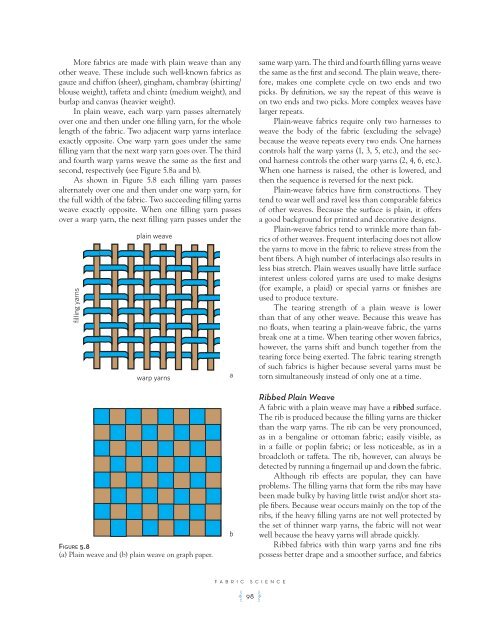You also want an ePaper? Increase the reach of your titles
YUMPU automatically turns print PDFs into web optimized ePapers that Google loves.
More fabrics are made with plain weave than any<br />
other weave. These include such well-known fabrics as<br />
gauze and chiffon (sheer), gingham, chambray (shirting/<br />
blouse weight), taffeta and chintz (medium weight), and<br />
burlap and canvas (heavier weight).<br />
In plain weave, each warp yarn passes alternately<br />
over one and then under one filling yarn, for the whole<br />
length of the fabric. Two adjacent warp yarns interlace<br />
exactly opposite. One warp yarn goes under the same<br />
filling yarn that the next warp yarn goes over. The third<br />
and fourth warp yarns weave the same as the first and<br />
second, respectively (see Figure 5.8a and b).<br />
As shown in Figure 5.8 each filling yarn passes<br />
alternately over one and then under one warp yarn, for<br />
the full width of the fabric. Two succeeding filling yarns<br />
weave exactly opposite. When one filling yarn passes<br />
over a warp yarn, the next filling yarn passes under the<br />
filling yarns<br />
plain weave<br />
warp yarns<br />
Figure 5.8<br />
(a) Plain weave and (b) plain weave on graph paper.<br />
a<br />
b<br />
FABRIC SCIENCE<br />
A 98 F<br />
same warp yarn. The third and fourth filling yarns weave<br />
the same as the first and second. The plain weave, therefore,<br />
makes one complete cycle on two ends and two<br />
picks. By definition, we say the repeat of this weave is<br />
on two ends and two picks. More complex weaves have<br />
larger repeats.<br />
Plain-weave fabrics require only two harnesses to<br />
weave the body of the fabric (excluding the selvage)<br />
because the weave repeats every two ends. One harness<br />
controls half the warp yarns (1, 3, 5, etc.), and the second<br />
harness controls the other warp yarns (2, 4, 6, etc.).<br />
When one harness is raised, the other is lowered, and<br />
then the sequence is reversed for the next pick.<br />
Plain-weave fabrics have firm constructions. They<br />
tend to wear well and ravel less than comparable fabrics<br />
of other weaves. Because the surface is plain, it offers<br />
a good background for printed and decorative designs.<br />
Plain-weave fabrics tend to wrinkle more than fabrics<br />
of other weaves. Frequent interlacing does not allow<br />
the yarns to move in the fabric to relieve stress from the<br />
bent fibers. A high number of interlacings also results in<br />
less bias stretch. Plain weaves usually have little surface<br />
interest unless colored yarns are used to make designs<br />
(for example, a plaid) or special yarns or finishes are<br />
used to produce texture.<br />
The tearing strength of a plain weave is lower<br />
than that of any other weave. Because this weave has<br />
no floats, when tearing a plain-weave fabric, the yarns<br />
break one at a time. When tearing other woven fabrics,<br />
however, the yarns shift and bunch together from the<br />
tearing force being exerted. The fabric tearing strength<br />
of such fabrics is higher because several yarns must be<br />
torn simultaneously instead of only one at a time.<br />
Ribbed Plain Weave<br />
A fabric with a plain weave may have a ribbed surface.<br />
The rib is produced because the filling yarns are thicker<br />
than the warp yarns. The rib can be very pronounced,<br />
as in a bengaline or ottoman fabric; easily visible, as<br />
in a faille or poplin fabric; or less noticeable, as in a<br />
broadcloth or taffeta. The rib, however, can always be<br />
detected by running a fingernail up and down the fabric.<br />
Although rib effects are popular, they can have<br />
problems. The filling yarns that form the ribs may have<br />
been made bulky by having little twist and/or short staple<br />
fibers. Because wear occurs mainly on the top of the<br />
ribs, if the heavy filling yarns are not well protected by<br />
the set of thinner warp yarns, the fabric will not wear<br />
well because the heavy yarns will abrade quickly.<br />
Ribbed fabrics with thin warp yarns and fine ribs<br />
possess better drape and a smoother surface, and fabrics













